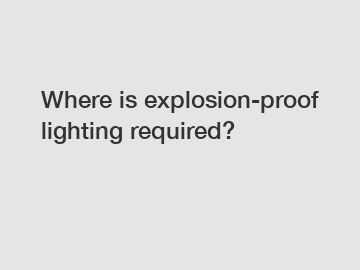Feb. 23, 2024
Lights & Lighting
Google hot topics:
1. What are explosion-proof lights and where are they required?
2. Safety regulations for explosion-proof lighting in hazardous environments.

3. Importance of explosion-proof lighting in industrial settings.
4. How to choose the right explosion-proof lighting for your facility.
Explosion-proof lighting is a critical component in industrial settings where the risk of explosions is present. These specialized lights are designed to prevent the ignition of flammable gases, vapors, or dust in hazardous environments. But where exactly are explosion-proof lights required? Let's explore this topic in more detail.
1. Definitions and regulations:
Explosion-proof lighting is designed to withstand and contain explosions within the fixture, preventing them from igniting hazardous substances in the environment. These lights are typically used in locations where flammable gases, vapors, or dust particles are present, such as chemical plants, oil refineries, and mines. The use of explosion-proof lighting is mandated by various safety regulations, including the National Electric Code (NEC), Occupational Safety and Health Administration (OSHA) standards, and the National Fire Protection Association (NFPA) guidelines.
2. Hazardous environments:
Explosion-proof lighting is required in areas classified as hazardous locations, where the concentration of flammable substances exceeds safe limits. These locations are typically classified into different zones based on the likelihood of a fire or explosion occurring. For example, Zone 0 is the most hazardous area where explosive gases are present continuously or for long periods, while Zone 2 is a less hazardous area where explosive gases are present only intermittently.
3. Specific applications:
Explosion-proof lighting is essential in a wide range of industrial settings, including oil and gas facilities, chemical processing plants, grain elevators, and manufacturing plants. In these environments, the risk of explosions is high due to the presence of flammable materials and potential sources of ignition, such as electrical equipment, motors, and heat-producing processes. By using explosion-proof lighting, companies can minimize the risk of accidents, protect their employees, and comply with safety regulations.
4. Choosing the right lighting:
When selecting explosion-proof lighting for a specific application, several factors need to be considered, including the type of hazardous material present, the temperature rating of the fixture, the level of protection required, and the mounting options available. It is essential to consult with a certified lighting specialist to ensure that the chosen fixtures meet the necessary safety standards and are suitable for the intended environment. Additionally, regular maintenance and inspections are crucial to ensure that the lights remain in good working condition and continue to provide adequate illumination.
In conclusion, explosion-proof lighting is a vital safety measure in industrial settings where the risk of explosions is a constant threat. By understanding where explosion-proof lighting is required and following the appropriate safety regulations, companies can create a safe working environment for their employees and prevent costly accidents and downtime. If you are unsure about the lighting requirements in your facility, consult with a lighting expert to ensure that you are in compliance with industry standards and regulations. Stay safe and well-lit in hazardous environments with explosion-proof lighting.
If you want to learn more, please visit our website explosion proof flexible conduit, Explosion-proof Technology, explosion proof panel board.
Previous: Does Cree make the best LED?
Next: Revolutionizing Home Lighting: Are PHILIPS LED Tubes Worth It?
If you are interested in sending in a Guest Blogger Submission,welcome to write for us!
All Comments ( 0 )